| Ancient people who built
Stonehenge more than 3,500 years ago could have used the monumental arrangement
of pillars to predict lunar eclipses, according to a professor of physics
and astronomy at Clarion University in Pennsylvania. |
| Sharon Challener, who has been studying
the megalith for more than 20 years, discovered a pattern in the puzzling
horseshoe-shaped row of vertical columns at Stonehenge's centre. Challener,
like so many others, had been trying for years to figure out what was the
purpose of Stonehenge. She had speculated about, and tested out, countless
celestial cycles as they may have lined up with the mysterious stones.
Then, almost by accident, she noticed that eclipses are visible from certain
locations on Earth in distinct 47-month cycles. |
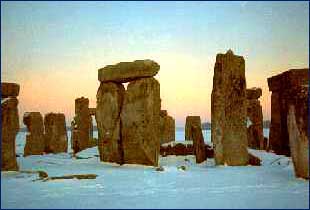 |
| That seemed to add up. There
were 19 upright columns at the monument's centre, which are collectively
called the Bluestone Horseshoe. If the Stonehengers placed some stone marker
on top of a pillar at one end of the horseshoe during a lunar eclipse and
moved the rock to the adjacent pillar every full moon, they could predict
successive eclipses. |
| Moving the rock this way
every lunar month, the marker would stand at the centre of the horseshoe
after two-and-a-half trips around the row -- 47 months after the original
eclipse. The full moon that rose that month would fall into Earth's shadow
during the night. That stone could then be taken down and moved to the
beginning of the horseshoe again. While it might sound complicated, the
method would actually be simple in practice, Challener said, and it would
work. |
| "It makes use of the youngest, most
central, most massive features of Stonehenge and it predicts all lunar
eclipses occurring at Stonehenge without predicting a lot of eclipses that
wouldn't be visible from the site," Challener said. |
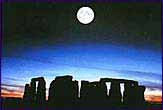
|
| Besides, nobody had to come
up with this system overnight. There is evidence that Stonehenge was begun
about 3000 BC, with additions continuing for more than 1,500 years. During
that time the people who built the mammoth structure may have been studying
the moon. Over time they may have noticed the eclipse pattern, and developed
an innovation to keep track of eclipses, she said. |
| It was sometime in the 1970s
when Challener became captivated with Stonehenge.Her father returned from
a visit to the ruins enthralled with the magnificent stacks of stones.
He passed on the enthusiasm to his daughter. Challener and her father built
scale models and toyed with them for years, trying to figure out how the
various celestial bodies would have aligned with the rocks. |
| "I played around with a lot of things,
putting it out in the sun, tilting it so that it would simulate Stonehenge"
But the sun shadows just never panned out, and so over the years Challener
decided that the megalith was mostly about the moon. |
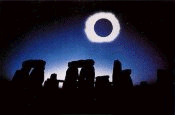
|
| "I thought that if the Stonehengers
were interested in the moon -- and they seemed to be because there were
indications that they had marked where the moon had risen and had been
able to predict full moons -- If they were at all interested in the moon,
they ought to have been interested in eclipses of the moon," she said. |
| Challener began by studying
when ancient eclipses would have been visible in southern England. "I had
tables of eclipses from way back when, and actually I stumbled on the 47
lunar months really by accident," she said. "I looked at the times between
lunar eclipses and did it really the old-fashioned way, which is the way
they might have done it. I just noticed a pattern." |
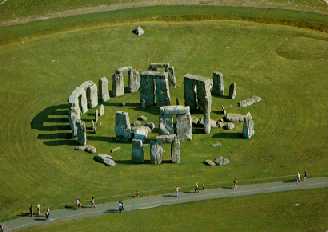
|
Stonehengers could
have kept track of lunar eclipses by moving rocks around the monuments
inner curve of 19 columns called the Bluestone Horseshoe. Placing a rock
on top of one of the horseshoe’s outermost columns during an eclipse and
moving it over one column every full moon, the marker would stand atop
the centre column during a full moon 47 months later, a moon that would
be eclipsed
|
| The trick that complicates
this explanation, however, is that more than one lunar eclipse would have
been visible from Stonehenge every 47 months. The keepers of the stones
could have had more than one rock travelling around the Bluestone Horseshoe
at once, Challener said. In fact, there may have been as many as six, depending
on the frequency of eclipses. No matter how often eclipse are seen within
a 47-month cycle, the eclipses that are separated by 47 months are all
related to each other. They form a sort of family, she said. |
| A family begins as a partial or penumbra
eclipse and it recurs every 47 months. Each time it would be a little closer
to a total eclipse. There might be a dozen or so total eclipses in the
family, and then the eclipses would grow more partial, eclipsing a smaller
part of the moon every 47 months until the eclipse failed to appear. That
family would then be finished, and the stone that marked it could be retired.
"There's no question it would work." Chaneller said. "Whether or not they
did it is more or less speculative." |
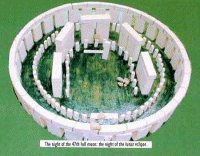
|
| There is no way to prove
that this method was really used, she said, and there is not any supporting
archaeological artefacts which show the Stonehengers were particularly
interested in the moon. After so many years of work, she said there is
something hauntingly dissatisfying about not really knowing what Stonehenge
was for. |